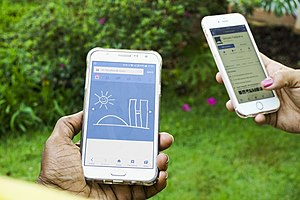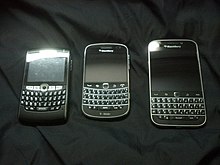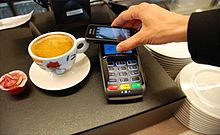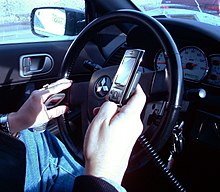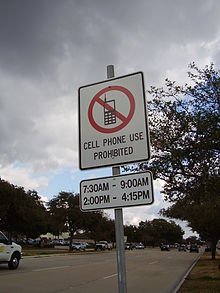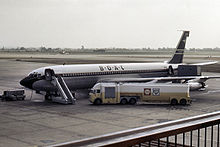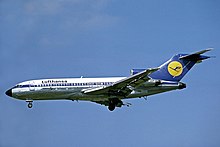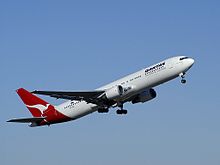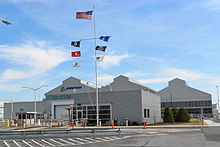Two smartphones: a Samsung Galaxy J5 (left) and an iPhone 6S (right)
Smartphones are a class of mobile phones and of multi-purpose mobile computing devices. They are distinguished from feature phones by their stronger hardware capabilities and extensive mobile operating systems, which facilitate wider software, internet (including web browsing over mobile broadband), and multimedia functionality (including music, video, cameras, and gaming), alongside core phone functions such as voice calls and text messaging. Smartphones typically include various sensors that can be leveraged by their software, such as a magnetometer, proximity sensors, barometer, gyroscope and accelerometer, and support wireless communications protocols such as Bluetooth, Wi-Fi, and satellite navigation.
Early smartphones were marketed primarily towards the enterprise market, attempting to bridge the functionality of standalone personal digital assistant (PDA) devices with support for cellular telephony, but were limited by their battery life, bulky form, and the immaturity of wireless data services. In the 2000s, BlackBerry, Nokia's Symbian platform, and Windows Phone began to gain market traction, with models often featuring QWERTY keyboards or resistive touchscreen input, and emphasizing access to push email and wireless internet. Since the unveiling of the iPhone in 2007, the majority of smartphones have featured thin, slate-like form factors, with large, capacitive screens with support for multi-touch gestures rather than physical keyboards, and offer the ability for users to download or purchase additional applications from a centralized store, and use cloud storage and synchronization, virtual assistants, as well as mobile payment services.
Improved hardware and faster wireless communication (due to standards such as LTE)
have bolstered the growth of the smartphone industry. In the third
quarter of 2012, one billion smartphones were in use worldwide. Global smartphone sales surpassed the sales figures for feature phones in early 2013.
History
Forerunner
IBM Simon and charging base (1994)
The first commercially available device that could be properly
referred to as a "smartphone" began as a prototype called "Angler"
developed by Frank Canova in 1992 while at IBM and demonstrated in November of that year at the COMDEX computer industry trade show. A refined version was marketed to consumers in 1994 by BellSouth under the name Simon Personal Communicator. In addition to placing and receiving cellular calls, the touchscreen-equipped Simon could send and receive faxes and emails.
It included an address book, calendar, appointment scheduler,
calculator, world time clock, and notepad, as well as other visionary
mobile applications such as maps, stock reports and news.
The term "smart phone" or "smartphone" was not coined until a year
after the introduction of the Simon, appearing in print as early as
1995, describing AT&T's PhoneWriter Communicator.
Early integration of data signals with telephony
The first caller identification receiver (1971)
The first integration of data signals with telephony was conceptualized by Nikola Tesla in 1909 and pioneered by Theodore Paraskevakos beginning in 1968 with his work on transmission of electronic data through telephone lines. In 1971, while he was working with Boeing in Huntsville, Alabama, Paraskevakos demonstrated a transmitter and receiver that provided additional ways to communicate with remote equipment. This formed the original basis for what is now known as caller ID. The first caller ID equipment was installed at Peoples' Telephone Company in Leesburg, Alabama
and was demonstrated to several telephone companies. The original and
historic working models are still in the possession of Paraskevakos.
PDA/phone hybrids
Beginning in the mid-late 1990s, many people who had mobile phones carried a separate dedicated PDA device, running early versions of operating systems such as Palm OS, Newton OS, Symbian or Windows CE/Pocket PC. These operating systems would later evolve into early mobile operating systems.
Most of the "smartphones" in this era were hybrid devices that combined
these existing familiar PDA OSes with basic phone hardware. The results
were devices that were bulkier than either dedicated mobile phones or
PDAs, but allowed a limited amount of cellular Internet access. The
trend at the time, however, that manufacturers competed on in both
mobile phones and PDAs was to make devices smaller and slimmer. The bulk
of these smartphones combined with their high cost and expensive data
plans, plus other drawbacks such as expansion limitations and decreased
battery life compared to separate standalone devices, generally limited
their popularity to "early adopters" and business users who needed portable connectivity.
In March 1996, Hewlett-Packard released the OmniGo 700LX, a modified HP 200LX palmtop PC with a Nokia 2110 mobile phone piggybacked onto it and ROM-based
software to support it. It had a 640×200 resolution CGA compatible
four-shade gray-scale LCD screen and could be used to place and receive
calls, and to create and receive text messages, emails and faxes. It
was also 100% DOS 5.0 compatible, allowing it to run thousands of existing software titles, including early versions of Windows.
The Nokia 9000 Communicator (right) and the updated 9110 model (left)
In August 1996, Nokia released the Nokia 9000 Communicator, a digital cellular PDA based on the Nokia 2110 with an integrated system based on the PEN/GEOS 3.0 operating system from Geoworks. The two components were attached by a hinge in what became known as a clamshell design, with the display above and a physical QWERTY keyboard below. The PDA provided e-mail; calendar, address book, calculator
and notebook applications; text-based Web browsing; and could send and
receive faxes. When closed, the device could be used as a digital
cellular telephone.
In June 1999 Qualcomm released the "pdQ Smartphone", a CDMA digital PCS smartphone with an integrated Palm PDA and Internet connectivity.
Subsequent landmark devices included:
- The Ericsson R380 (2000) by Ericsson Mobile Communications. The first device marketed as a "smartphone", it was the first Symbian-based phone, with PDA functionality and limited Web browsing on a resistive touchscreen utilizing a stylus. Users could not install their own software on the device, however.
- The Kyocera 6035 (early 2001), a dual-nature device with a separate Palm OS PDA operating system and CDMA mobile phone firmware. It supported limited Web browsing with the PDA software treating the phone hardware as an attached modem.[16][17]
- Handspring's Treo 180 (2002), the first smartphone that fully integrated the Palm OS on a GSM mobile phone having telephony, SMS messaging and Internet access built in to the OS. The 180 model had a thumb-type keyboard and the 180g version had a Graffiti handwriting recognition area, instead.
Japanese cell phones
In 1999, Japanese wireless provider NTT DoCoMo launched i-mode, a new mobile internet
platform which provided data transmission speeds up to 9.6 kilobits per
second, and access web services available through the platform such as
online shopping. NTT DoCoMo's i-mode used cHTML, a language which restricted some aspects of traditional HTML
in favor of increasing data speed for the devices. Limited
functionality, small screens and limited bandwidth allowed for phones to
use the slower data speeds available. The rise of i-mode helped NTT
DoCoMo accumulate an estimated 40 million subscribers by the end of
2001, and ranked first in market capitalization in Japan and second
globally. This power would later wane in the face of the rise of 3G and
new phones with advanced wireless network capabilities. Japanese cell
phones increasingly diverged from global standards and trends to offer
other forms of advanced services and functionality, such as mobile payments, near-field communication (NFC), and 1seg mobile television.
Early smartphones
Several BlackBerry smartphones, which were highly popular in the mid-late 2000s
Smartphones were still rare outside Japan until the introduction of the Danger Hiptop in 2002, which saw moderate success among U.S. consumers as the T-Mobile Sidekick. Later, in the mid-2000s, business users in the U.S. started to adopt devices based on Microsoft's Windows Mobile, and then BlackBerry smartphones from Research In Motion. American users popularized the term "CrackBerry" in 2006 due to the BlackBerry's addictive nature.
Outside the U.S. and Japan, Nokia was seeing success with its smartphones based on Symbian, originally developed by Psion for their personal organizers, and it was the most popular smartphone OS in Europe during the middle to late 2000s. Initially, Nokia's Symbian smartphones were focused on business with the Eseries,
similar to Windows Mobile and BlackBerry devices at the time. From 2006
onward, Nokia started producing consumer-focused smartphones,
popularized by the entertainment-focused Nseries. Until 2010, Symbian was the world's most widely used smartphone operating system.
Form factor shift
The original Apple iPhone;
its introduction contributed to the steady rise of smartphones that
feature large touchscreen interfaces without physical keypads
In the 2000s, it was common for smartphones to have a physical T9 numeric keypad or QWERTY keyboard in either a candybar or sliding form factor. Some smartphones had resistive touchscreens, which allowed for virtual keyboards and handwriting input with a finger or a stylus, thus also allowing easy entry of Asian characters.
In 2007, the LG Prada was the first mobile phone released with a large capacitive touchscreen. Later that year, Apple Computer introduced the iPhone. The iPhone was also designed around a large capacitive touchscreen, but added support for multi-touch
gestures (for interactions such as "pinching" to zoom in and out on
photos and web pages). Such phones were notable for abandoning the use
of a stylus, keyboard, or keypad typical for smartphones at the time, in
favor of a capacitive touchscreen for direct finger input as its only
input type. The invention of the touchscreen smartphone is often
attributed to Apple, but they actually made the smartphone as we know it
today something mainstream due to the company's popularity in the US
(and to a lesser extent worldwide) and they made popular the way that
people interact with smartphones. Following the iPhone's success despite
its original retail price of over US$500, other smartphone
manufacturers started to use the same basic design of the iPhone.
The iPhone was "not a smartphone by conventional terms, being
that a smartphone is a platform device that allows software to be
installed", until the opening of Apple's App Store a year later, which became a common means for smartphone software distribution and installation. The first iPhone also faced criticism for not supporting the latest 3G
wireless network standards, but was praised for its hardware and
software design, and its June 2007 release was met with heavy demand,
with customers waiting in lines outside Apple Store locations to be among the first to purchase it.
The screen-focused hardware of phones centered around a
capacitive touchscreen stimulated the software to focus on features such
as a web browser designed to render full web pages (as opposed to
stripped down WAP
services), multimedia functionality (such as music and videos), and
online services such as maps apps. This, along with the iPhone's
appraisal and Apple's popularity and influence, was a key factor in the
initial success of the iPhone.
The advantages of a design around a capacitive touchscreen affected the development of another smartphone OS platform, Android (and later Blackberry 10),
with a more BlackBerry-like prototype device scrapped in favor of a
touchscreen device with a slide-out physical keyboard, as Google's
engineers thought at the time that a touchscreen could not completely
replace a physical keyboard and buttons. The first Android device, the HTC Dream, was released in September 2008.
Although Android's adoption was relatively slow at first, it started
gaining widespread popularity in 2010, largely due to its functionality
at a low price, and in early 2012 dominated the smartphone market share
worldwide, which continues to this day. Android is based around a
modified Linux kernel, which makes Linux the most widely used operating
system worldwide, and it also makes Android the most widely used general
purpose operating system worldwide. Apple's iPhones are more widespread
in rich, developed countries than in relatively poor and developing
countries, where having an iPhone or a high end Android smartphone is
considered a luxury.
Android and iPhone devices popularized the smartphone form factor based on a large capacitive touchscreen, and led to the decline of earlier, keyboard- and keypad-focused platforms. Microsoft, for instance, discontinued Windows Mobile and started a new touchscreen-oriented OS from scratch, called Windows Phone.
Nokia abandoned Symbian and partnered with Microsoft to use Windows
Phone on its smartphones. Windows Phone became the third-most-popular
smartphone OS, before being replaced by Windows 10 Mobile, which declined in share to become "largely irrelevant" at less than 0.5% of the smartphone market. Palm replaced their Palm OS with webOS. BlackBerry Limited, formerly known as Research In Motion, made a new platform based on QNX, BlackBerry 10,
with which it was possible to control a device without having to press
any physical buttons; this platform was later discontinued.
By the mid-2010s, almost all smartphones were touchscreen-only, and Android and iPhone
smartphones dominated the market, with Android being more popular in
developing countries, and the iPhone being more popular in developed,
rich countries.
Developments in the 2010s
The iPhone X.
In the early 2010's, larger smartphones dubbed "phablets" began to achieve popularity, with Samsung's Galaxy Note series gaining notably wide adoption.
In 2013, Fairphone launched its first "socially ethical" smartphone at the London Design Festival to address concerns regarding the sourcing of materials in the manufacturing followed by Shiftphone in 2015.
In late 2013, QSAlpha commenced production of a smartphone designed
entirely around security, encryption and identity protection. Some companies began to release smartphones incorporating flexible displays to create curved form factors, such as the Samsung Galaxy Round and LG G Flex.
In October 2013, Motorola Mobility announced Project Ara, a concept for a modular smartphone
platform that would allow users to customize and upgrade their phones
with add-on modules that attached magnetically to a frame. Ara was retained by Google following its sale of Motorola Mobility to Lenovo, but was shelved in 2016. That year, LG and Motorola both unveiled smartphones featuring a limited form of modularity for accessories; the LG G5 allowed accessories to be installed via the removal of its battery compartment, while the Moto Z utilizes accessories attached magnetically to the rear of the device.
The first smartphone with a fingerprint reader was the Motorola Atrix 4G in 2011. In September 2013, the iPhone 5S was unveiled as the first smartphone on a major U.S. carrier since the Atrix to feature this technology.
By 2014, 1440p displays began to appear on high-end smartphones. In 2015, Sony released the Xperia Z5 Premium, featuring a 4K resolution
display, although only images and videos could actually be rendered at
that resolution (all other software is upscaled from 1080p). Microsoft, expanding upon the concept of Motorola's short-lived "Webtop", unveiled functionality for its Windows 10 operating system for phones that allows supported devices to be docked for use with a PC-styled desktop environment. Other major technologies began to trend in 2016, including a focus on virtual reality and augmented reality experiences catered towards smartphones, the newly introduced USB-C connector, and improving LTE technologies. As of 2015, the global median for smartphone ownership was 43%. Statista forecast that 2.87 billion people would own smartphones in 2020.
New trends for smartphone displays began to emerge in 2017, with
both LG and Samsung releasing flagship smartphones utilizing displays
with taller aspect ratios than the common 16:9
ratio. These designs allow the display to have a larger diameter, but
with a slimmer width than 16:9 displays with an equivalent screen size.
Another trend popularized that year were designs—colloquially known as a
"notch"—where the front-facing camera, and sometimes other sensors
typically located along the top bezel of a device, are contained into a
tab-like area at the top of the device that the display wraps around.
These designs allow for "edge-to-edge" displays that take up nearly the
entire height of the device, with little to no bezel along the top. This
design characteristic was popularized by the Essential Phone (which featured a circular tab for its camera) and iPhone X (which used a wider tab to contain a camera and facial scanning system). In 2018, the first smartphones featuring fingerprint readers embedded within OLED displays were announced.
An example of a flexible display
Smartphones with foldable
displays have been theorized as possible in the future, but that
current manufacturing processes and costs made them commercially
unfeasible.
In November 2018, the startup company Royole unveiled the first
commercially-available smartphone with a folding display, the FlexPai.
Also that month, Samsung unveiled a concept of its "Infinity Flex
Display" at its developers conference, with a prototype device featuring
a smaller, outer display on its "cover", and revealing a larger,
tablet-sized display when opened. Samsung stated that it also had to
develop a new polymer material to coat the display as opposed to glass. Early examples of foldable phones from other manufacturers became the subject of rumors in early 2019.
Hardware
Central processing unit
Smartphones have central processing units (CPUs), similar to those in computers, but optimized to operate in low power environments.
The performance of mobile CPU depends not only on the clock rate (generally given in multiples of hertz) but also on the memory hierarchy.
Because of these challenges, the performance of mobile phone CPUs is
often more appropriately given by scores derived from various
standardized tests to measure the real effective performance in commonly
used applications.
Display
A smartphone touchscreen
One of the main characteristics of smartphones is the screen.
Depending on the device's design, the screen fills most or nearly all
of the space on a device's front surface. Many smartphone displays have
an aspect ratio of 16:9, but taller aspect ratios became more common in 2017.
Screen sizes are measured in diagonal inches. Phones with screens larger than 5.2 inches are often called "phablets".
Smartphones with screens over 4.5 inches in size are commonly difficult
to use with only a single hand, since most thumbs cannot reach the
entire screen surface; they may need to be shifted around in the hand,
held in one hand and manipulated by the other, or used in place with
both hands. Due to design advances, some modern smartphones with large
screen sizes and "edge-to-edge" designs have compact builds that improve
their ergonomics, while the shift to taller aspect ratios have resulted
in phones that have larger screen sizes whilst maintaining the
ergonomics associated with smaller 16:9 displays.
Liquid-crystal displays are the most common; others are IPS, LED, OLED, and AMOLED displays. Some displays are integrated with pressure-sensitive digitizers, such as those developed by Wacom and Samsung, and Apple's Force Touch system.
Sound
Some audio quality enhancing features, such as Voice over LTE and HD Voice
have appeared and are often available on newer smartphones. Sound
quality can remain a problem due to the design of the phone, the quality
of the cellular network and compression algorithms used in long distance calls. Audio quality can be improved using a VoIP application over WiFi. Cellphones have small speakers so that the user can use a speakerphone
feature and talk to a person on the phone without holding it to their
ear. The small speakers can also be used to listen to digital audio
files of music or speech or watch videos with an audio component,
without holding the phone close to the ear.
Battery
A high-capacity portable battery charger
By the end of 2017, smartphone battery life has become generally adequate;
however, earlier smartphone battery life was poor due to the weak
batteries that could not handle the significant power requirements of
the smartphones' computer systems and color screens.
Smartphone users purchase additional chargers for use outside the
home, at work, and in cars and by buying portable external "battery
packs". External battery packs include generic models which are
connected to the smartphone with a cable, and custom-made models that
"piggyback" onto a smartphone's case. In 2016, Samsung had to recall
millions of the Galaxy Note 7 smartphones due to an explosive battery issue. For consumer convenience, wireless charging stations have been introduced in some hotels, bars, and other public spaces.
Accessories
A wide range of accessories are sold for smartphones, including cases, screen protectors, power charging cables, wireless power stations, USB On-The-Go adapters (for connecting USB drives and or, in some cases, a HDMI cable to an external monitor), add-on batteries, headphones, combined headphone-microphones (which, for example, allow a person to privately conduct calls on the device without holding it to the ear), and Bluetooth-enabled powered speakers that enable users to listen to media from their smartphones wirelessly.
Cases range from relatively inexpensive rubber or soft plastic
cases which provide moderate protection from bumps and good protection
from scratches to more expensive, heavy-duty cases that combine a rubber
padding with a hard outer shell. Some cases have a "book"-like form,
with a cover that the user opens to use the device; when the cover is
closed, it protects the screen. Some "book"-like cases have additional
pockets for credit cards, thus enabling people to use them as wallets.
Accessories include products sold by the manufacturer of the smartphone and compatible products made by other manufacturers.
Software
Mobile operating systems
A mobile operating system (or mobile OS) is an operating system for phones, tablets, smartwatches, or other mobile devices.
Mobile operating systems combine features of a personal computer
operating system with other features useful for mobile or handheld use;
usually including, and most of the following considered essential in
modern mobile systems; a touchscreen, cellular, Bluetooth, Wi-Fi Protected Access, Wi-Fi, Global Positioning System (GPS) mobile navigation, video- and single-frame picture cameras, speech recognition, voice recorder, music player, near field communication, and infrared blaster. By Q1 2018, over 383 million smartphones were sold with 85.9 percent running Android, 14.1 percent running iOS and a negligible number of smartphones running other OSes.
Android alone is more popular than the popular desktop operating system
Windows, and in general smartphone use (even without tablets) exceeds
desktop use.
Mobile devices with mobile communications abilities (e.g.,
smartphones) contain two mobile operating systems – the main user-facing
software platform is supplemented by a second low-level proprietary real-time operating system
which operates the radio and other hardware. Research has shown that
these low-level systems may contain a range of security vulnerabilities
permitting malicious base stations to gain high levels of control over the mobile device.
Mobile app
A mobile app is a computer program designed to run on a mobile
device, such as a smartphone. The term "app" is a short-form of the term
"software application".
Application stores
The introduction of Apple's App Store for the iPhone and iPod Touch in July 2008 popularized manufacturer-hosted online distribution for third-party applications (software and computer programs) focused on a single platform. There are a huge variety of apps, including video games, music products and business tools. Up until that point, smartphone application distribution depended on third-party sources providing applications for multiple platforms, such as GetJar, Handango, Handmark, and PocketGear.
Following the success of the App Store, other smartphone manufacturers
launched application stores, such as Google's Android Market (later
renamed to the Google Play Store) and RIM's BlackBerry App World and Android-related app stores like F-Droid. In February 2014, 93% of mobile developers were targeting smartphones first for mobile app development.
Sales
Since 1996, smartphone shipments have had positive growth. In
November 2011, 27% of all photographs created were taken with
camera-equipped smartphones. In September 2012, a study concluded that 4 out of 5 smartphone owners use the device to shop online. Global smartphone sales surpassed the sales figures for feature phones in early 2013.
Worldwide shipments of smartphones topped 1 billion units in 2013, up
38% from 2012's 725 million, while comprising a 55% share of the mobile
phone market in 2013, up from 42% in 2012. In Q1 2016 for the first time the shipments dropped by 3 percent year on year. The situation was caused by the maturing China market.
By manufacturer
In 2011, Samsung had the highest shipment market share
worldwide, followed by Apple. In 2013, Samsung had 31.3% market share, a
slight increase from 30.3% in 2012, while Apple was at 15.3%, a
decrease from 18.7% in 2012. Huawei, LG and Lenovo were at about 5%
each, significantly better than 2012 figures, while others had about
40%, the same as the previous years figure. Only Apple lost market
share, although their shipment volume still increased by 12.9%; the rest
had significant increases in shipment volumes of 36–92%. In Q1 2014, Samsung had a 31% share and Apple had 16%. In Q4 2014, Apple had a 20.4% share and Samsung had 19.9%. In Q2 2016, Samsung had a 22.3% share and Apple had 12.9%.
In Q1 2017, IDC reported that Samsung was first placed, with 80 million
units, followed by Apple with 50.8 million, Huawei with 34.6 million,
Oppo with 25.5 million and Vivo with 22.7 million.
Samsung's mobile business is half the size of Apple's, by
revenue. Apple business has been increasing very rapidly over the past 4
years.
Social
A 2012 University of Southern California study found that unprotected adolescent sexual activity was more common among owners of smartphones. A study conducted by the Rensselaer Polytechnic Institute's (RPI) Lighting Research Center (LRC) concluded that smartphones, or any backlit devices, can seriously affect sleep cycles. Some persons might become psychologically attached to smartphones resulting in anxiety when separated from the devices. A "smombie" (a combination of "smartphone" and "zombie")
is a walking person using a smartphone and not paying attention as they
walk, possibly risking an accident in the process, an increasing social
phenomenon. The issue of slow-moving smartphone users led to the temporary creation of a "mobile lane" for walking in Chongqing, China. The issue of distracted smartphone users led the city of Augsburg, Germany to embed pedestrian traffic lights in the pavement.
Mobile banking and payment
Mobile payment system.
In many countries, mobile phones are used to provide mobile banking services, which may include the ability to transfer cash payments by secure SMS text message. Kenya's M-PESA mobile banking service, for example, allows customers of the mobile phone operator Safaricom
to hold cash balances which are recorded on their SIM cards. Cash can
be deposited or withdrawn from M-PESA accounts at Safaricom retail
outlets located throughout the country and can be transferred
electronically from person to person and used to pay bills to companies.
Branchless banking has been successful in South Africa and the Philippines. A pilot project in Bali was launched in 2011 by the International Finance Corporation and an Indonesian bank, Bank Mandiri.
Another application of mobile banking technology is Zidisha,
a US-based nonprofit micro-lending platform that allows residents of
developing countries to raise small business loans from Web users
worldwide. Zidisha uses mobile banking for loan disbursements and
repayments, transferring funds from lenders in the United States to
borrowers in rural Africa who have mobile phones and can use the
Internet.
Mobile payments were first trialled in Finland in 1998 when two Coca-Cola vending machines in Espoo
were enabled to work with SMS payments. Eventually, the idea spread and
in 1999, the Philippines launched the country's first commercial mobile
payments systems with mobile operators Globe and Smart.
Some mobile phones can make mobile payments via direct mobile billing schemes, or through contactless payments if the phone and the point of sale support near field communication (NFC).
Enabling contactless payments through NFC-equipped mobile phones
requires the co-operation of manufacturers, network operators, and
retail merchants.
While driving
A New York City driver holding two phones
A user consulting a mapping app on a phone
Mobile phone use while driving—including calling, text messaging, playing media, web browsing, gaming,
using mapping apps or operating other phone features—is common but
controversial, since it is widely considered dangerous due to what is
known as distracted driving. Being distracted while operating a motor vehicle has been shown to increase the risk of accidents. In September 2010, the US National Highway Traffic Safety Administration (NHTSA) reported that 995 people were killed by drivers distracted by phones. In March 2011 a US insurance company, State Farm Insurance, announced the results of a study which showed 19% of drivers surveyed accessed the Internet on a smartphone while driving.
Many jurisdictions prohibit the use of mobile phones while driving. In
Egypt, Israel, Japan, Portugal and Singapore, both handheld and
hands-free calling on a mobile phone (which uses a speakerphone)
is banned. In other countries including the UK and France and in many
US states, only the use of calling on handheld phones is banned, while
hands-free use is permitted.
A 2011 study reported that over 90% of college students surveyed text (initiate, reply or read) while driving.
The scientific literature on the danger of driving while sending a text message from a mobile phone, or texting while driving, is limited. A simulation study at the University of Utah found a sixfold increase in distraction-related accidents when texting.
Due to the complexity of smartphones that began to grow more after,
this has introduced additional difficulties for law enforcement
officials when attempting to distinguish one usage from another in
drivers using their devices. This is more apparent in countries which
ban both handheld and hands-free usage, rather than those which ban
handheld use only, as officials cannot easily tell which function of the
phone is being used simply by looking at the driver. This can lead to
drivers being stopped for using their device illegally for a call when,
in fact, they were using the device legally, for example, when using the
phone's incorporated controls for car stereo, GPS or satnav.
A sign along Bellaire Boulevard in Southside Place, Texas (Greater Houston) states that using mobile phones while driving is prohibited from 7:30 am to 9:30 am and from 2:00 pm to 4:15 pm
A 2010 study reviewed the incidence of phone use while cycling and its effects on behavior and safety.
In 2013 a national survey in the US reported the number of drivers who
reported using their phones to access the Internet while driving had
risen to nearly one of four.
A study conducted by the University of Vienna examined approaches for
reducing inappropriate and problematic use of mobile phones, such as
using phones while driving.
Accidents involving a driver being distracted by being in a call on a phone have begun to be prosecuted as negligence similar to speeding. In the United Kingdom,
from 27 February 2007, motorists who are caught using a handheld phone
while driving will have three penalty points added to their license in
addition to the fine of £60. This increase was introduced to try to stem the increase in drivers ignoring the law. Japan
prohibits all use of phones while driving, including use of hands-free
devices. New Zealand has banned handheld phone use since 1 November
2009. Many states in the United States have banned text messaging on
phones while driving. Illinois became the 17th American state to enforce
this law. As of July 2010, 30 states had banned texting while driving, with Kentucky becoming the most recent addition on July 15.
Public Health Law Research maintains a list of distracted driving laws in the United States.
This database of laws provides a comprehensive view of the provisions
of laws that restrict the use of mobile devices while driving for all 50
states and the District of Columbia between 1992, when first law was
passed through December 1, 2010. The dataset contains information on 22
dichotomous, continuous or categorical variables including, for example,
activities regulated (e.g., texting versus talking, hands-free versus
handheld calls, web browsing, gaming), targeted populations, and
exemptions.
Legal
A "patent war" between Samsung and Apple started when the latter claimed that the original Galaxy S Android phone copied the interface—and possibly the hardware—of Apple's iOS for the iPhone 3GS. There was also smartphone patents licensing and litigation involving Sony Mobile, Google, Apple Inc., Samsung, Microsoft, Nokia, Motorola, HTC, Huawei and ZTE, among others. The conflict is part of the wider "patent wars" between multinational technology and software corporations. To secure and increase market share, companies granted a patent
can sue to prevent competitors from using the methods the patent
covers. Since the 2010s the number of lawsuits, counter-suits, and trade
complaints based on patents and designs in the market for smartphones, and devices based on smartphone OSes such as Android and iOS,
has increased significantly. Initial suits, countersuits, rulings,
license agreements, and other major events began in 2009 as the
smartphone market stated to grow more rapidly by 2012.
Facsimile
Some apps allows for sending and receiving facsimile (Fax), over a smartphone, including facsimile data (composed of raster bi-level graphics) generated directly and digitally from document and image file formats.
Medical
With the rise in number of mobile medical apps in the market place,
government regulatory agencies raised concerns on the safety of the use
of such applications. These concerns were transformed into regulation
initiatives worldwide with the aim of safeguarding users from untrusted
medical advice.
Security
Smartphone malware is easily distributed through an insecure app store. Often, malware is hidden in pirated versions of legitimate apps, which are then distributed through third-party app stores.
Malware risk also comes from what is known as an "update attack", where
a legitimate application is later changed to include a malware
component, which users then install when they are notified that the app
has been updated.
As well, one out of three robberies in 2012 in the United States
involved the theft of a mobile phone. An online petition has urged
smartphone makers to install kill switches in their devices.
In 2014, Apple's "Find my iPhone" and Google's "Android Device Manager"
can locate, disable, and wipe the data from phones that have been lost
or stolen. With BlackBerry Protect in OS version 10.3.2, devices can be
rendered unrecoverable to even BlackBerry's own Operating System
recovery tools if incorrectly authenticated or dissociated from their
account.
Leaked documents published by WikiLeaks, code-named Vault 7 and dated from 2013–2016, detail the capabilities of the United States Central Intelligence Agency (CIA) to perform electronic surveillance and cyber warfare, including the ability to compromise the operating systems of most smartphones (including iOS and Android).
Guidelines for mobile device security were issued by NIST
and many other organizations. For conducting a private, in-person
meeting, at least one site recommends that the user switch the
smartphone off and disconnect the battery.
Sleep
Using smartphones late at night can disturb sleep, due to the blue light and brightly lit screen, which affects melatonin levels and sleep cycles. In an effort to alleviate these issues, several apps that change the color temperature
of a screen to a warmer hue based on the time of day to reduce the
amount of blue light generated have been developed for Android, while iOS 9.3
integrated similar, system-level functionality known as "Night Shift".
Amazon released a feature known as "blue shade" in their Fire OS
"Bellini" 5.0 and later. It has also been theorized that for some users,
addicted use of their phones, especially before they go to bed, can
result in "ego depletion". Many people also use their phones as alarm clocks, which can also lead to loss of sleep.
Bokeh cameras
Pocket cameras have difficulty producing bokeh
in images, but nowadays, some smartphones have dual-lens cameras that
produce the bokeh effect easily, and can even rearrange the level of
bokeh after shooting. The iPhone 7 Plus debuted with a dual-lens camera in the back of the smartphone. More advanced smartphones may come with 'quad cameras', or two dual-lens cameras such as the Honor
9 Lite smartphone. The back and front of the smartphone each have a
13MP main lens and a 2MP lens for capturing depth information. The Evercoss U50A Max smartphone has 4 cameras, and costs less than $100.
Huawei P20 Pro
smartphone with triple lenses in the back of the smartphone has been
launched as bokeh camera smartphone with optical zoom. First lens has
40MP RGB, second lens has 20MP monochrome and third lens has 8MP RGB telephoto
3x. The zoom can be enhanced to 5x with combination of the optical zoom
and megapixel lens 40MP RGB to produce undeteriorated (optical+digital)
zoom or digital zoom without loss of quality.
